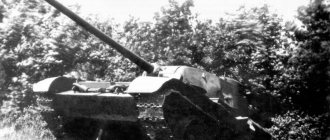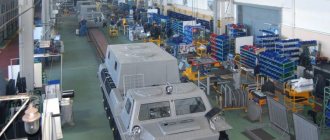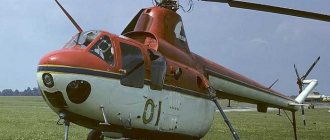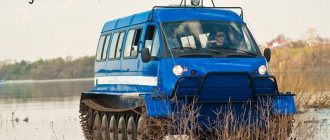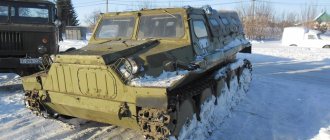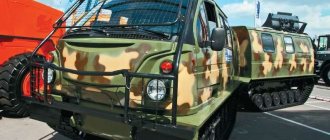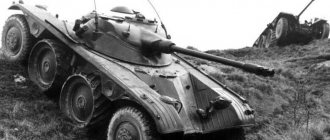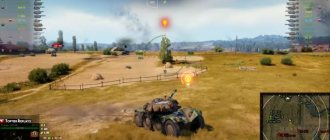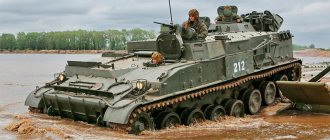The GAZ tracked snow and swamp-going vehicle is designed for transporting people and cargo over rough terrain, tundra, and snow cover. The main emphasis in the design of the machine is on reliability and functionality. Simple repairable components were used without unnecessary complications. The GAZ all-terrain vehicle is floating, and for floating vehicles the most appropriate arrangement is in a welded steel body made of thin sheets without a frame. Almost all armored personnel carriers are made according to this scheme. It was also chosen for GAZ-34039.
Main technical characteristics:
- Dimensions - 5720x2550x2130 mm;
- Curb weight – 4900 kg;
- Load capacity - 1200 kg;
- Cabin for 2 seats + lounge for 10 people;
- Engine - 110 hp;
- Fuel consumption - 50 l/100 km;
- Ground clearance 400 mm;
- Overcome descent/ascent - 35 degrees;
- Side roll angle - 25 degrees;
- Movement on water - 6 km/h;
- The weight of the towed trailer is 2000 kg.
Design Features
The main distinctive features of the Soviet all-terrain vehicle can be considered the following:
- Minimum number of structural elements;
- Low-speed tractor diesel of the Minsk Motor Plant MMZ D24512S;
- Upper hatches in the cabin, allowing you to get out if the all-terrain vehicle is flooded;
- Double-glazed glazing. All double-glazed windows, including two windshield windows, are made flat to reduce the cost of their replacement;
- The cabin and interior are insulated with lightweight polymer insulation;
- For mechanical protection of the cabin, a tubular frame is installed;
- The gearbox and main gear are combined in one housing;
- Drive to front sprockets, which resulted in a significant reduction in the number of transmission elements;
- Independent torsion bar suspension with a minimum number of parts.
The GAZ-34039 chassis is used for the production of all-terrain vehicles with a large number of modifications. There are about two dozen options for the body: 34039-22, -32, -33, -13, -12 and others. The cabin platform is made universal and can be easily converted to any task.
Hand leopard
The snow leopard was named after the snow leopard, a keen and agile wild cat.
Today is his weather! Frost, knee-deep snow. I open the door shortened at the bottom and climb into the cabin. There is no driving position. There is no steering wheel - all that remains is a hub and steering columns. On the sides of the driver's seat there are two huge handbrake levers. These are control levers. Pure surrealism!
Gazelle windows are large, visibility is good. But what about such glazing into the forest? That’s why branch cutters and protective nets are installed on the Irbis.
The front panel is from GAZelle Business. The chairs are from her, there is longitudinal adjustment. The back can be reclined back. Additional gear lever: it acts as a transfer case. The gearbox is 5-speed. The same is installed on the all-wheel drive GAZ Sadko.
The front panel is from GAZelle Business. The chairs are from her, there is longitudinal adjustment. The back can be reclined back. Additional gear lever: it acts as a transfer case. The gearbox is 5-speed. The same is installed on the all-wheel drive GAZ Sadko.
The driver and passenger seats have three-point seat belts, rather than lap belts, as on many wheeled all-terrain vehicles. And this is great, because it is unclear what deep snow can hide. If you're wearing a waist belt, you'll run into a tree stump and smash your forehead on the front panel.
Out of habit, I engage first gear like a car, without pressing the clutch pedal. In response - a characteristic crunch. The technique is harsh, you have to press the pedal like a man and all the way.
The instrument panel is from a GAZelle. This year they began installing an engine hour meter here.
The instrument panel is from a GAZelle. This year they began installing an engine hour meter here.
The left control lever folds, making it easier to get into the driver's seat.
The left control lever folds, making it easier to get into the driver's seat.
On a rutted road, where only tracked transporters go, the Irbis drives calmly, without dancing on uneven surfaces inherent in short-wheelbase all-terrain vehicles. No caterpillar clang, no tractor-like grinding motion.
Left lever - towards yourself. A band brake with six floating shoes slows down the movement of the left track, and the nose of the car is already looking into the white silence of the snow field. Nimble! The turning radius is only 2.2 meters. I move the additional gear lever away from me - it’s like shifting into low gear in a car transfer case. Now gas - and straight to the fields!
The all-terrain vehicle can carry twelve people, ten can be accommodated in the back. The backs of the “sofas” rise to form four sleeping places.
The all-terrain vehicle can carry twelve people, ten can be accommodated in the back. The backs of the “sofas” rise to form four sleeping places.
The snow leopard creeps imposingly through the snowy expanses. It glides across deep virgin soil on its belly and stubbornly makes its way with caterpillars, raising fountains of snow. The capabilities of the Minsk diesel engine with its 423 Newton-meters of torque are enough to row in the snow and climb hills.
I pull the right lever - it doesn’t want to! It's like I'm stopping the all-terrain vehicle from turning. This is true. You need to work with the levers in doses and increase the turning radius. Otherwise, the caterpillar shovels snow into itself, like a shovel, and the all-terrain vehicle gets stuck. But still, a tracked vehicle can do much more than a wheeled vehicle. Where the wheelman demands to release the pressure and turn on the locks, the Irbis passes without straining.
HHRTThe Zavolzhsky Crawler Tractor Plant has been producing all-terrain vehicles for more than half a century. In July 1968, the first tracked transporter GAZ-71 GT-SM was assembled here. The all-terrain vehicle carried a ton of cargo and was in demand in the army and in civilian life. The car was produced until 1985, then several upgrades were made. The most modern modification, GAZ‑34039, is still produced to this day in a variety of versions. In the photo there is a firefighting snow and swamp-going vehicle. Factory workers also carried out very exclusive orders. In 2015, four GAZ Bobr and Irbis all-terrain vehicles were sent to the Middle East. Check out the interior decoration of the Irbis. Genuine leather, and on the front panel there is imitation wood. Noise and vibration insulation has been improved, there is a rear view camera, central locking, electric windows, multimedia with a touch screen, navigation and CD/MP3 player. | ||
Crawler conveyor GAZ‑71 GT-SM. |
Firefighter all-terrain vehicle |
Export Irbis interior trim: genuine leather, imitation wood on the front panel. |
Crawler propulsion system for impassable off-road conditions
In off-road conditions, tracked vehicles continue to be the most passable. It copes with roads in the tundra better than new models of all-terrain vehicles with low pressure tires. In addition, a low pressure tire is a very vulnerable mechanical component. If there is a puncture, the all-terrain vehicle breaks down, and it is impossible to carry a spare set of tires due to their weight and size. Caterpillars, on the contrary, are mechanically very strong. That is why they are used on military equipment. In this regard, classic tracked all-terrain vehicles will be in service for a long time and no replacement is expected. At the request of the customer, two types of tracks can be installed: ОШ and РМШ.
The predecessor GAZ-34039 GAZ-71 tracks did not have a rear sprocket. In this regard, the angle of attack when reversing was very large. Once in a depression (for example, in a river bed), the possibilities for reversing were greatly limited. Subsequently, the designers completely eliminated this defect.
Search and rescue version
The maneuverable snow and swamp-going vehicle is equipped in accordance with customer requirements; - "drilling rig". At the request of the customer, such small drilling machines as BGM-1M, UKB12/25, UBShM 1, BBU-000 “Openok”, UBShM 1-20, KMB 2-15, as well as a compressor for core drilling with purging type MZA20 with operating pressure are installed 7 kgf/cm2 and productivity up to 6m3 per minute; - “residential module”. The cabin height of 1.8 meters allows you to stand at full height. For passenger comfort, it is equipped with air conditioning, a microwave and a refrigerator. There is a table, a developed storage system, and five sleeping places.
The updated all-terrain vehicle GAZ-34039 “Irbis”, which can be purchased on our website, is characterized by an increased payload capacity of up to two tons and a voluminous monobody. The manufacturer has also added the number of passenger seats - now twelve people can travel on the all-terrain vehicle. The overall dimensions allow you to move unhindered on public roads, and the high ground clearance (400 millimeters) allows you to easily overcome any obstacles. The tracked vehicle has the following cross-country ability:
- lateral roll angle - 250;
- climbing angle - 350;
- turning radius – 2.2 m;
- specific pressure on the ground - 0.25 kg/cm2.
The interior of the GAZ-34039 has become more comfortable. Now it has an additional autonomous heating circuit installed. Particular attention has been paid to the driver's seat: the instrument panel and cabin visibility have been improved. The thermal and noise insulation of the all-terrain vehicle has also been improved - fifty-degree frost is no longer a hindrance to it. The Irbis is equipped with a four-cylinder diesel engine with a displacement of 4.75 liters and an operating power of 122 hp. (90 kW), and the maximum torque is 260 Nm. Now it is located in the cabin - this greatly simplifies maintenance at extreme temperatures outside. About 30 liters of fuel are consumed per 100 kilometers, the reserve is 185 liters. Main technical characteristics:
- The maximum speed on the highway is 63 km/h;
- The maximum speed afloat is 5 km/h;
- Overall dimensions (l/w/h) - 6070/2570/2670 mm;
- Track - 2180 mm;
- Base - 3600 mm;
- Number of seats – 12;
- Number of beds – 4;
- Load capacity - 2000kg;
- Weight when fully equipped – 5000 kg;
- The maximum permissible trailer weight is 2000 kg.
Engine and transmission
The heart of the all-terrain vehicle is the MMZ D245.12S diesel engine. One of the best engine models from the Minsk Motor Plant (MMZ) was selected. The main indicator of quality is efficiency and reliability. In terms of efficiency, the motor is at the level of the best world standards and consumes 218-250 g. diesel fuel per 1 kW of power. Total power - 110 hp. The working volume is 4750 cc. The compression ratio is 15. The weight of the engine equipped with auxiliary units in the crankcase together with the clutch is 500 kg.
The designers chose a low-speed tractor diesel engine. If for automobile diesel engines the operating speed with maximum torque is 3000-5000 rpm, then for D245-12S it is 2400 rpm. Reducing the rotation speed leads to increased reliability. The load on engine components is significantly reduced.
Transmission
Tracked all-terrain vehicles emphasize simplicity of design. Even on more expensive modifications, for example, GAZ-34039 Irbis, only a simple manual transmission is installed. The gearbox is located in the cabin and is covered with a noise-proof casing. Number of steps – 5 + reverse. A friction clutch is used to turn. The transmission compartment is located under the hood in the front part of the cabin.
The driver of the GAZ all-terrain vehicle controls three levers: turns left/right and the gearbox switch. Instruments indicating fuel level, oil level and temperature are made without electronics. They use only reliable mechanical parts. Maximum reduction in the number of electronic devices is a necessary condition for operating all-terrain vehicles in northern conditions. Access to the mechanical components of the all-terrain vehicle is through three hatches:
- hood in front of the cab (separation of the turning mechanisms and gearboxes for the tracks);
- hinged gearbox cover in the cab;
- the hood of the engine compartment between the cabin and the passenger compartment.
Fire version
The body is a version of the GAZ-34039 Irbis all-terrain vehicle and is painted with red heat-resistant paint. Additionally installed are a bumper bumper, windshield protection, an electric winch Come-Up 15 DV, and two fire extinguishers. All passenger seats are equipped with seat belts. On the sides and in the cabin there are shelves and drawers for equipment and accessories. The delivery set includes a 50-piece entrenching tool set, sleeping bags, four-bed tourist tents and first aid kits.
Chassis
Consists of 12 track rollers. Each roller has its own independent torsion bar suspension unit. GAZ spare parts for the chassis offer two types of rollers. The differences can be seen in the photographs.
The support roller is a lightweight steel disk produced by stamping with welding on a wide rim, but another design is more popular. In it, two convex disks are welded into a three-dimensional structure. A rubber ring is placed on the rim. Rubberized rollers significantly extend the service life of the tracks. Typically it is 6,000 km, and with tracks with additional rubber shock absorbers - 12,000 km.
The short service life of the tracks is a factor limiting the operation of an all-terrain vehicle when transporting people and cargo over long distances. On paved and unpaved roads (passable for ordinary vehicles), it is recommended to transport it on a trailer. Loading is possible on a regular cargo trailer using a crane or by moving an all-terrain vehicle on an inclined plane (loading onto a tow truck). Weight and size characteristics do not impose restrictions on the transportation of an all-terrain vehicle on regular roads.
Interior heater Webasto
In northern conditions, interior heating is especially important. Using heat from a diesel engine to heat the cabin would reduce engine reliability, so it is not used. To heat the interior, a reliable autonomous interior heater from Webasto is installed. It is also a pre-heater for the engine. And here the designers found good optimization. Webasto produces heaters for cabins of trucks, vans, minibuses and buses. Installing a heater from a major manufacturer simplifies the search for spare parts. Fuel consumption - 100-250 g/h.
All-terrain vehicle GAZ-34039 Irbis (modification - residential module)
The GAZ-34039 “Irbis” snow and swamp all-terrain vehicle model (modification “residential module”) is specially created for operation in particularly difficult road and climatic conditions, for transporting people and goods off public roads. Distinctive features of the all-terrain vehicle from previous models:
- Volumetric monobody,
- Increased number of seats,
- Comfortable salon.
The ergonomics of the driver's workplace have been significantly improved, the instrument panel, and visibility of the cabin and passenger compartment have been improved.
The modified layout of the engine compartment - the engine was moved into the cabin - made it easier to service the power unit.
The vehicle's carrying capacity has been increased to 2 tons.
The snow and swamp-going vehicle is designed for operation and garage-free storage at ambient temperatures from -40°C to + 40°C, as well as in mountainous areas with altitudes above sea level of up to 4650 m.
Able to overcome water obstacles. Movement afloat is carried out using a caterpillar propulsion unit.
Passenger version:
- Cabinets and lockers for accessories - 2 pcs.
- Salon for 10 people
Passenger module:
- Designed to carry 10 passengers or for autonomous living of five people in various climatic conditions at ambient temperatures from -40°C to +40°C.
- The maximum speed of a tracked floating all-terrain vehicle with a passenger module is 60 km/h.
- The module configuration is made in accordance with customer requirements.
Heating system: consists of two independent circuits:
- autonomous heating circuit “WEBASTO” Air Top 3900;
- dependent circuit - from the cooling system of the transport vehicle.
Ventilation system:
- Ventilation hatch;
- Air conditioner Dometric B2600-1 on the roof;
- Opening windows.
Electrical equipment:
- From the on-board network with a rated operating voltage of 24 V;
- From an external source of alternating voltage 220 V (remote diesel generator SDG 4000GLE 3 kW/220 V), transported in the engine compartment;
- Engine pre-heater WEBASTO Termo 90 ST;
- Flashing Light;
- Electric heater 220V-EPD35.
Interior equipment:
- 5 sleeping places;
- Table;
- 2 wardrobes;
- Luggage racks and compartments;
- Interior thermal insulation;
- Double side glazing;
- Escape hatch;
- Intercom between the driver's cabin and the passenger module;
- Refrigerator Waeco CoolMatic CR65 50 l.;
- Combined interior lighting (2 ceiling lamps, sconce lamp);
- Socket (24V), socket (220V) ;
- Microwave oven Samsung Heavyduty RoadMate RM-17-24;
- Voltage converter 24-220V;
- Telematic module of the vehicle monitoring system using GLONASS technologies (GLONASS/GPS) - AutoGraph - GSM-1;
- Medical kit;
- Fire extinguisher;
- Places for installing an antenna and a radio receiver (car radio).
External equipment
- A staircase built into the side of the cargo platform to ensure independent boarding (disembarking) of passengers into and out of the module;
- Roof rack with a load capacity of 200 kg;
- Lighting complex OK-1 with a luminous flux power of at least 1000 W;
- Means of protection against vandalism;
- Emergency gas analyzer in the cabin - 1 pc.;
- Winch DV-15 with a force of at least 6.8 tons;
- Windshield windshield deflectors;
- Rear door window grille;
- Side window protection;
Comparison with predecessor GAZ-71
The uneconomical carburetor engine ZMZ-41 was replaced with a diesel engine D24512S. As a result, fuel consumption was halved (50 l/100 km instead of 100 l/100 km), and the fuel itself was replaced from gasoline to diesel. The total cost of operation has decreased by three times. The all-terrain vehicle has become fuel-unified with trucks, heaters, drilling rigs and other equipment widely used in the far north.
A rear sprocket has been added, the angle of attack of the track when moving in reverse has become the same as in the front.
The power reserve has been increased from 400 to 700 km. With a consumption of 50 l/100 km, the total tank capacity is 370 l.
